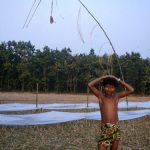- Work in progress
- Work in progress
- Installation view
- Detail
- Installation view with a boy
W O R K S H O P O F C O N T E M P O R A R Y A R T O F A S I A , A F R I C A A N D T H E P A C I F I C R I M, BRAC Center, Rajendrapur, Bangladesh, 2002
In cooperation with: The Bengal Foundation, Bangladesh Shilpaka Academy
bamboo, jute rope, earth, polythene sheet
A chronicle of an alignment,
An alignment of cosmic patterns,
An alignment of rice with Mecca,
The rising levels of water bring destruction and fertility,
The rice is ripe,
the seeds gathered together on top of the stem sing the song of Bangladesh to the whispering winds.
Bangladesh is a collaboration between Nobuho Nagasawa and Iranian architect Daryoush Saidi. It records the inseparable links between the forces of nature, the people and myth. The installation developed during a brisk two-hour walk just after dawn in the beautiful countryside of Rajendrapur. Bangladesh’s dependence on the cycle of seasons of rice and water creates a bond between nature and the people. Nine points of power were marked with stalks of bamboo in the rice field, symbolizing the nine months of preg- nancy—the human season. In Bangladesh most people pray toward Mecca. A compass revealed that the rice field is aligned in the direction of Mecca as well. Surely the sustenance of life and the power of belief are bound together.
Bangladesh is a delta country, with flat land and wide rivers. The rivers that bring life also bring floods, caus- ing death and destruction. The floodwaters also fertilize the soil, enriching the land and bringing prosperity to the people. The polythene sheets that move with the wind measure the ever-changing water level in the rice field. A 30-foot stalk of rice rises toward the sky in the direction of Mecca; at its end hangs the fruit of the rice farmers’ labor. It is a symbol of hope and promise for those who cultivate the land and bind the culture together. The entire project was conceived and executed in less than one and a half days—the result of a series of coincidence. It became the chronicle of an alignment of two artists’ fates.






